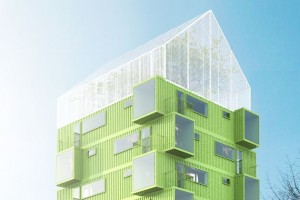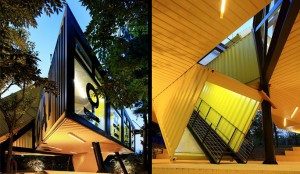Jure Kotnik, an architect based in Slovenia and founder of Arhitektura Jure Kotnik office, is known for his projects in the field of container architecture.
Kotnik was curator of world’s first Container Architecture Exhibition held in Berlin (Platoon Gallery). Also, he is the author of two monographs on the topic.
First monograph, “Container Architecture: This book contains 6441 containers”, features various projects from around the globe, including student housing complex in Stockholm (1026 containers), cruise line center in Hamburg (48 containers), museum in Seoul (166 containers), public buildings, retail pavilions, private residences (1-12 containers). His second monograph “New Container Architecture: Design and Sustainability” was published recently, in July 2013. We ask Jure Kotnik about his new book and container-based architecture.
Why do you start to deal with container architecture? What inspired you?
Jure Kotnik: I came across container based projects when I was doing a low cost prefab research and I found many outstanding examples of container architecture. I noticed there were yet no literature or extensive research about and this drag me into it.
What’s new in you second book on container architecture in comparison with the first book? Which topics does it cover?
JK: If the first book was establishment of container architecture as a new branch of architecture, the second book is more about its positioning within the streams architecture. It is a sum-up of all that happened in the field of container architecture in the last 10 years. The new book includes a design guide for creating container architecture project and a case study of 30 exceptional projects. Novelties are several QR codes with video links adding new dimension to the project presentation.
Do you have some favorite architects/architectural firms that use containers in some of their projects?
JK: I do not have my favorite architect or office, however there are many exceptional projects that I like and who transform a simple steel box into high quality architecture. Container based projects have also won several important architectural prizes over the years and have been included into many important selections of world architecture. All that is proving their quality. Therefore good architecture is more defined with how you build it, not so much with what you build.
 Containerhouse KTH, Stockholm, Sweden © sandellsandberg arkitekter AB
Containerhouse KTH, Stockholm, Sweden © sandellsandberg arkitekter AB
Is shipping container an appropriate medium for habitable architecture (if you know that it is limited in the measures of a transport system)? Are containers a good solution for modular housing?
JK: One container can hardly represent a quality space for living due to its limited dimensions and corridor shape. Architects started to prove the opposite, but soon they started to expand the container using various extensions and then continued with combining containers into bigger projects. At the moment we have many container architecture projects that are a combination of containers and other construction materials which positions container architecture more towards the other prefab constructions. The results of such approach can be really good for housing. If we focus on container modules only, containers could be very useful for some hotels or student housings, both as temporal or long term investment.
 2+ Weekend house, Trebnie, Slovenia © Jure Kotnik Arhitekt
2+ Weekend house, Trebnie, Slovenia © Jure Kotnik Arhitekt
According to you, what are the pros and cons of using containers as elements of architectural design?
JK: Containers are sturdy and durable architectural material, their modularity, easy transport, lightweight, cost and perhaps even trendiness are its most evident PROs. While their CONs are: limited space – If using one module only, their manipulation needs special equipment like cranes or forklifts, sometimes transformation can also be costly, sometimes there might be some issues with building permits and there can also be some prejudices for such construction. There are people who see containers more suitable for homeless or to house people in third world countries, while the examples show quite the opposite – quality container architecture actually mostly appears in rich and most developed countries from Switzerland, Norway, EU countries, Japan, South Korea to USA and Canada for example.
 APAP OpenSchool, Anyang, Korea © LOT-EK
APAP OpenSchool, Anyang, Korea © LOT-EK
Many architects and designers are skeptics regarding container architecture. Can you say us what are the possibilities of container architecture?
JK: Container architecture functions best where its main characteristics can take place – those are mobility and fast assembly. Those characteristics enable the possibility to host an event or to launch a commercial space in front of Paris’s Notre Dame today, while tomorrow you can move it in front of Buckingham’s Palace in London. This possibility will keep container projects around in future for sure.
Can shipping container be reinvented? Will container architecture ever be a “huge thing”? Will it ever have wider use in residential architecture except for social one?
JK: Container architecture is a niche. That there are roughly around 30 million twenty-foot equivalent containers in the world today. If we convert all of them into buildings, this would cover China’s construction needs in 2010 for 78 days only. That explains all about the influence. However I believe that container architecture is not the final destination, it is a way to there.
